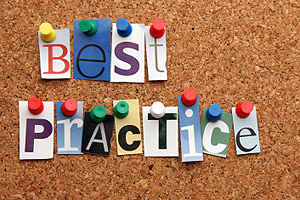This is the second in a series of three posts highlighting bits from my International Social Media Association (ISMA) teleseminar: Strategies to Ensure an Engaged Social Presence.
ISMA: You talked about ‘employing Best Practices’ techniques just now. Can you expand a little on what this may include — let’s start with Best Practices for Twitter?
Twitter Best Practices for Brands
- Make sure your bio is filled out and have a well-branded page. See how to optimize your Twitter bio for more tips. I suggest using your business name in the real name because this is what’s indexed by Google.
- Use 120 characters…they say 120 is the new 140. Write your tweets with retweeting in mind. Ideally you’ll want to keep your character count to 120 leaving plenty of room for retweeting without the original tweet being hacked.
- Use Keywords for SEO in tweets and load them in the front of the tweet. Not always easy to do but worth keeping in mind.
- Use the RT@ at the end of the tweet (helps with SEO)
- Be generous and thankful. Always thank those who re-tweet you, or give you a #ff or shout out.
- Provide useful, helpful information. This will help to establish your Twitter credibility and establish your brand as a leader in its field/industry.
- Try to include a link in 90% of your tweets. Use a URL shortener like bit.ly or ow.ly (from HootSuite). These provide tweet statistics which are useful in determining the most interesting content to your followers.
- Avoid text message abbreviations, pay attention to grammar and spelling.
- Try to be mindful of the 80/20 rule. That is, 80% of your tweets should be helpful or conversational while only 20% should be promotional.
- Use someone’s first names when tweeting to them.
- Be genuine! Authenticity is the golden rule in social media (via Mashable). You and your brand both need to be believable. Give a human voice to your brand and don’t be afraid to let your enthusiasm and spirit show in your tweets.
ISMA: And how about on Facebook? Do the same rules apply? Are there Best Practices for Facebook as well?
Best Practices for Facebook
- Facebook is about community around a brand — it’s about creating relationships with your customers or potential customers.
- Make sure your Fan page is branded. People should be able to have instant recognition with your page.
- Monitor your wall (make sure your notifications are on) (not a feature for fan pages not associated with a profile)
- Provide good unique content — start conversations, chat, ask questions, and always respond to any comment on your wall…positive or negative.
- Be conversational vs. corporate (again, speak with a human voice vs. a corporate voice)
- Create events
- Ultimately you want to make an enjoyable environment for fan page
And nuggets of Best Practices for Social Media.
- Understand, you do not control the message. Old habits die hard and there’s a tendency to want to treat social media participation like advertising where the ability to control messaging is the norm.
- Commit resources & time to be successful or you may very well fail. It’s important to forecast labor hours, who, what, when, how and where with the intention of succeeding, not just experimenting.
- Be fun and visual: Visuals play a big part in the user experience you provide. They engage and help you capture consumers’ attention for a longer time.
- Relationships first. Business second: Remember that social media is relational, not transactional.
- Give to Get: A well-executed social media strategy requires reciprocity, relevancy, transparency, authenticity, but perhaps above all other things, commitment.

